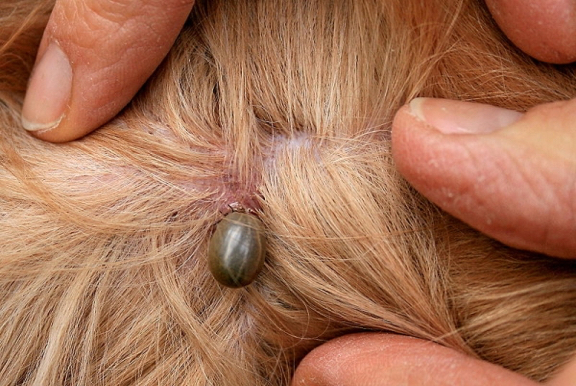Lyme disease is caused by a bacteria that is transmitted through a bite from a black legged tick (deer tick). These ticks are very small ranging in size from a poppy seed to a sesame seed.
Clinical Signs of Lyme Disease
After a tick carrying the lyme bacteria attaches to the skin it takes 24-48 hours to transmit disease. Prompt removal of ticks or a really good tick prevention can help prevent lyme disease. Most dogs exposed to lyme disease will not become sick. Dogs that do get sick usually start to develop symptoms between 2-5 months after the tick bite.
Most common signs of illness are fever, lameness, lethargy, decreased appetite, and joint swelling and pain. A less common but more severe complication of lyme disease can be kidney damage. Signs of this disease include vomiting, not eating, increased thirst and extreme lethargy.
Diagnosis can be made with antigen and antibody testing. If your dog tests positive your veterinarian will likely advise additional blood and urine testing to evaluate your pet for any signs of kidney damage.
Treatment often involves treatment with antibiotics and pain medication if needed for joint pain. If there were any other changes on lab work additional tests or monitoring may be recommended.
In cases where the kidneys are involved (lyme nephritis) treatment is more aggressive the the long term prognosis is poor. Hospitalization requires addressing the severe kidney disease with IV fluids, medication to

help with protein loss, nausea medication, antibiotics, and potentially immunosuppressive medications. When dogs are asymptomatic and do not become sick the prognosis is very good. For dogs that become ill with joint pain a majority of them will get better but there may be some chronic pain related to any arthritis development. For dogs that have kidney involvement the prognosis is poor and may of them do not survive.
In ten years of practice I have had two patients develop lyme nephritis and it was fatal in both cases. A handful of patients that develop clinical signs and recover with mild long term pain. The vast majority test positive but never develop clinical disease. This is a preventable disease but not all tick preventions are created equal and no parasite prevention is 100% all the time. A good tick prevention (find a product that will protect against species of ticks that are endemic to your area) in addition to annual testing for the disease and the annual lyme vaccine are the best protection you can offer your pet.
Female Adult Deer Ticks – Stages of Feeding


 Barks & Recreation is proud to feature Dr. Eileen Savier CVA, CVCH as our Veterinary Blogger in our “From the Vet” Series — offering information related to the health and welfare of your furry family members! Currently part of the team of doctors at Keystone Veterinary Clinic, Dr. Savier is a 2012 Graduate of the Ross University School of Veterinary Medicine, She completed her clinical experience at The Ohio State University and after veterinary school she pursued further education and certification in Veterinary Acupuncture, Chinese Herbal Medicine, and Fear Free veterinary visits. Dr. Savier has a special interest in integrative medicine, animal behavior, and internal medicine and is committed to improving animal health care by integrating Eastern and Western philosophies. She enjoys working with fearful & aggressive dogs and cats and she has had additional training in low stress handling techniques and encourages positive reinforcement during exams and procedures. Her clinical interests include pain management, animal behavior, geriatric patient care, and internal medicine.
Barks & Recreation is proud to feature Dr. Eileen Savier CVA, CVCH as our Veterinary Blogger in our “From the Vet” Series — offering information related to the health and welfare of your furry family members! Currently part of the team of doctors at Keystone Veterinary Clinic, Dr. Savier is a 2012 Graduate of the Ross University School of Veterinary Medicine, She completed her clinical experience at The Ohio State University and after veterinary school she pursued further education and certification in Veterinary Acupuncture, Chinese Herbal Medicine, and Fear Free veterinary visits. Dr. Savier has a special interest in integrative medicine, animal behavior, and internal medicine and is committed to improving animal health care by integrating Eastern and Western philosophies. She enjoys working with fearful & aggressive dogs and cats and she has had additional training in low stress handling techniques and encourages positive reinforcement during exams and procedures. Her clinical interests include pain management, animal behavior, geriatric patient care, and internal medicine. Dr. Savier shares her home with two (soon to be three) dogs, two cats, and a toddler. She lovingly refers to her two dogs as Coconut Retrievers as they were rescue dogs she brought home from the island of St. Kitts. In her free time she enjoys spending time with her family, going to the beach, and planning her next Disney vacation.
Dr. Savier shares her home with two (soon to be three) dogs, two cats, and a toddler. She lovingly refers to her two dogs as Coconut Retrievers as they were rescue dogs she brought home from the island of St. Kitts. In her free time she enjoys spending time with her family, going to the beach, and planning her next Disney vacation.




